
Cygnus is a northern constellation on the plane of the Milky Way, deriving its name from the Latinized Greek word for swan. Cygnus is one of the most recognizable constellations of the northern summer and autumn, and it features a prominent asterism known as the Northern Cross. Cygnus was among the 48 constellations listed by the 2nd century astronomer Ptolemy, and it remains one of the 88 modern constellations.

Musca is a small constellation in the deep southern sky. It was one of 12 constellations created by Petrus Plancius from the observations of Pieter Dirkszoon Keyser and Frederick de Houtman, and it first appeared on a celestial globe 35 cm (14 in) in diameter published in 1597 in Amsterdam by Plancius and Jodocus Hondius. The first depiction of this constellation in a celestial atlas was in Johann Bayer's Uranometria of 1603. It was also known as Apis for 200 years. Musca remains below the horizon for most Northern Hemisphere observers.
The Tolman–Oppenheimer–Volkoff limit is an upper bound to the mass of cold, non-rotating neutron stars, analogous to the Chandrasekhar limit for white dwarf stars. If the mass of a neutron star reaches the limit it will collapse to a denser form, most likely a black hole.

Westerlund 1 is a compact young super star cluster about 3.8 kpc away from Earth. It is thought to be the most massive young star cluster in the Milky Way, and was discovered by Bengt Westerlund in 1961 but remained largely unstudied for many years due to high interstellar absorption in its direction. In the future, it will probably evolve into a globular cluster.

Zeta Cygni is a binary star system in the northern constellation of Cygnus, the swan. It has an apparent visual magnitude of 3.26 and, based upon parallax measurements, is about 143 light-years away.
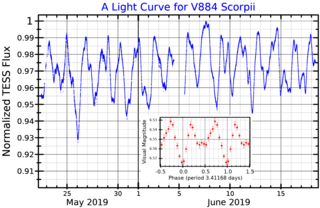
4U 1700-37 is one of the stronger binary X-ray sources in the sky, and is classified as a high-mass X-ray binary. It was discovered by the Uhuru satellite. The "4U" designation refers to the fourth Uhuru catalog.

Beta Muscae, Latinized from β Muscae, is a binary star in the southern circumpolar constellation of Musca. With a combined apparent visual magnitude of 3.07, it is the second brightest star in the constellation. Judging by the parallax results, it is located at a distance of roughly 340 ± 13 light-years from the Earth.
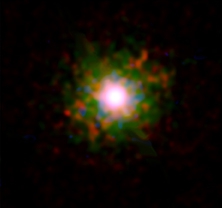
Circinus X-1 is an X-ray binary star system that includes a neutron star. Observation of Circinus X-1 in July 2007 revealed the presence of X-ray jets normally found in black hole systems; it is the first of the sort to be discovered that displays this similarity to black holes. Circinus X-1 may be among the youngest X-ray binaries observed.

X Persei is a high-mass X-ray binary system located in the constellation Perseus, approximately 950 parsecs away. It is catalogued as 4U 0352+309 in the final Uhuru catalog of X-ray objects.
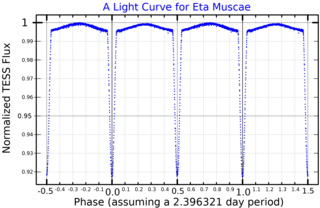
Eta Muscae is a multiple star system in the southern constellation of Musca. It is visible to the naked eye as a faint, blue-white hued point of light with an apparent visual magnitude of 4.79. The system is located around 406 light years away from the Sun. It is a member of the Lower Centaurs Crux subgroup of the Sco OB2 stellar association of co-moving stars.

Theta Muscae is a multiple star system in the southern constellation Musca, containing a Wolf-Rayet star and two massive companions. With an apparent magnitude of 5.5, it is the second-brightest Wolf–Rayet star in the sky, although much of the visual brightness comes from the massive companions and it is not one of the closest of its type.
Zeta1 Muscae, Latinized from ζ1 Muscae and abbreviated ζ1 Mus, is a suspected astrometric binary star system in the constellation Musca, located 2.6° west of Beta Muscae. It is bright enough to be visible to the naked eye as a dim, orange-hued star with an apparent visual magnitude of 5.73, forming a visual pair with nearby Zeta2 Muscae. The ζ1 Mus system is around 417 light-years distant from the Sun, based on parallax, and is drifting further away with a radial velocity of +21 km/s.

S Muscae is a classical (δ) Cepheid variable star in the constellation Musca about 2,600 light years away.

TU Muscae, also known as HD100213, is an eclipsing binary star in the constellation Musca. Its apparent magnitude ranges from 8.17 to 8.75 over around 1.4 days.
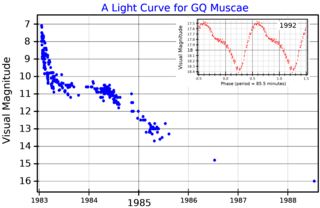
GQ Muscae, also known as Nova Muscae 1983 is a nova in the constellation Musca, which was discovered by William Liller at 03:20 UT on 18 January 1983. At the time of its discovery it was a magnitude ≈7.2 object, and it subsequently faded.
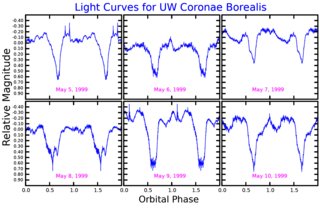
UW Coronae Borealis, also known as MS 1603.6+2600, is a low-mass X-ray binary star system in the constellation Corona Borealis. Astronomer Simon Morris and colleagues discovered the X-ray source in 1990 and were able to match it up with a faint star with an average visual magnitude of 19.4. The system is thought to be made up of a neutron star that has an accretion disk that draws material from its companion, a star less massive than the Sun. The disk is asymmetrical. The variability of the system is complex, with several periods identified: the two components orbit each other every 111 minutes, while there is another period of 112.6 minutes. The beat period of these is 5.5 days, which is thought to represent the precession of the asymmetrical accretion disk around the neutron star.
QV Normae, also known as Norma X-2, is a high mass X-ray binary star system in the constellation Norma. It varies between apparent magnitudes of 16.19 and 16.31.

Aquila X-1 is a low-mass x-ray binary (LMXB) and the most luminous X-Ray source in the constellation Aquila. It was first observed by the satellite Vela 5B which detected several outbursts from this source between 1969 and 1976. Its optical counterpart is variable, so it was named V1333 Aql according to the IAU standards. The system hosts a neutron star that accretes matter from a main sequence star of spectral type K4. The binary's orbital period is 18.9479 hours.
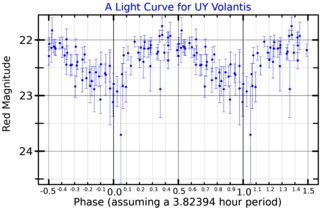
UY Volantis, also known as EXO 0748-676, is a low mass X-ray binary system located in the constellation Volans. With an apparent magnitude of 16.9, it requires a powerful telescope to see. With a radial velocity of 20 km/s, it is drifting away from the Solar System, and is currently located 26,000 light years away.

GT Muscae, also known as 12 Muscae, is a variable star about 400 light years from the Earth, in the constellation Musca. It is a 5th magnitude star, so it should be faintly visible to the naked eye of an observer far from city lights. It is a quadruple star system, consisting of a spectroscopic binary containing an RS Canum Venaticorum variable star, orbiting an eclipsing binary. It varies in brightness from magnitude 4.96 to 5.23. GT Muscae is a very active X-ray source.















